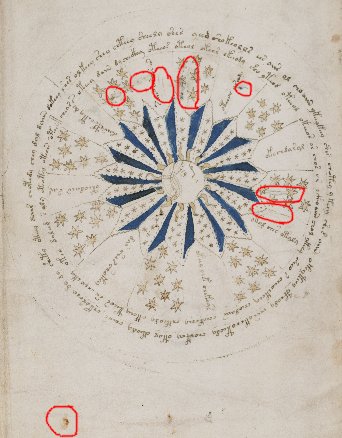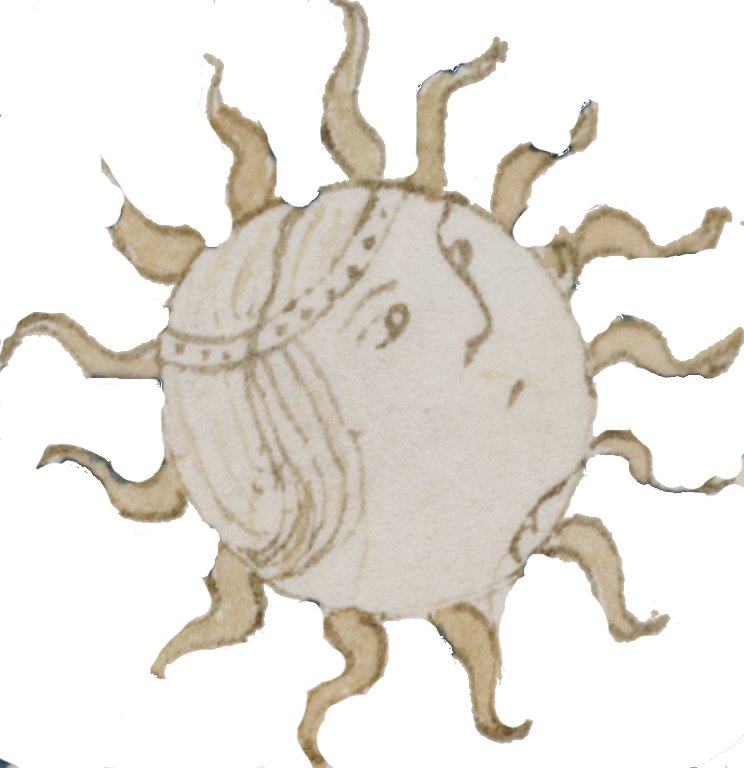Edith Sherwood recently flagged the “sun-face” at the middle of f68v1 as being a representation of Apollo, and that this “could indicate an association with Roman mythology“. Certainly, the face is tilted slightly upward and is linked with the sun, both features you might (naively, iconologically) expect to point to Apollo. If only Voynich research was that simple! Let’s start by taking a look at the sun-face in context, in particular the paints….

Here, the red-coloured contact transfer (from f69r) at the bottom left clearly happened after the pages were rebound in the wrong order [f68v1’s “sun-face” initially sat beside f67r1’s “moon-face”], bringing to my mind the bloodstain imagined on the Sarajevo Haggadah by Geraldine Brooks in her novel “People of the Book” (which I’ll review here shortly). There are also “blue-edge” paint transfers (also from f69r) at 11.30, 12.00, 3.00, and 3.30, as well as some contact-transferred green “pipe-ends” at 10.30, 11, and 1 o’clock.
Given that the dirty black-blue paint on f68v1 appears to be identical to the one used on f69r, it seems extremely likely to me that the blue and green paints on both pages were later additions, whereas f68v1’s far paler yellow paint (which is covered over by the blue in a number of places) gives the distinct impression of being original. The ‘alpha’ (i.e. original) state of the page was therefore very likely to be just the drawings and the yellow paint only. If you snip away all the distracting blue paint in a a picture editor, you’d get something like this:-

With all the distracting blue paint removed, we can start to see more clearly what was being drawn. For instance, we can see the lines marking the front and back of the neck: and once we see those, we can see the wobbly line marking the back of the head (inside the circle). However, this appears to me to go over the dotted “headband” – and so the headband was apparently drawn first.
There is also a curious small loop where the head’s left ear would be, partially disguised by the rays, which I find reminiscent of the kind of stubby metal loops you see on astrolabes.
I therefore argue that this codicological evidence suggests that the alpha state of the image was probably a circle with a dotted arc that has been made to look as though it is a headband (when a face was added) – and so I would say that any resemblance to Apollo is very probably incidental to the real meaning of the page.
Dotted lines seem to have a particular resonance for the VMs’ author in several other places, and I have long suggested that these might very well indicate that meaningful information has been visually encoded. My guess here is that this was the briefest of sketches to allude to some kind of 15th century solar instrument – not an astrolabe, but something broadly similar.
To me, all this exemplifies the problem with looking for iconographic matches on the VMs’ sleek surface: in most cases, the basic codicological study (that ought to precede any searching for meaning) seems not to have been done – far too often, people skip to the chase without really looking at the page first.
Oh well! 😮
Houston, we have a problem…
I’d like a little clarification. When you say, “the alpha state of the image was probably a circle with a dotted arc that has been made to look as though it is a headband (when a face was added),” do you mean that the face wasn’t there or intended in the alpha state, and was added later, by someone beside the Author, as the paint was? Or are you thinking that it was probably an embellishment by the Author of the sketch of the proto-astrolable?
Yes, the face was probably an embellishment by the Author of the sketch of the early astronomical instrument, but specifically done so as to disguise the instrument as a headband. The (original) yellow paint went on afterwards, so it’s all part of the author’s cunning plan (whatever that is). 🙂